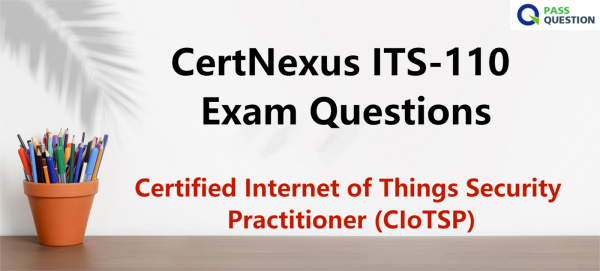CertNexus ITS-110 Exam Questions - Certified Internet of Things Security Practitioner (CIoTSP)
Now you can pass the ITS-110 Certified Internet of Things Security Practitioner (CIoTSP) exam with ease. PassQuestion provides excellent quality CertNexus ITS-110 Exam Questions that will help you in reaching your goal easily. Studying CertNexus ITS-110 Exam Questions will help you in clearing all of your doubts about the Certified Internet of Things Security Practitioner exam. They have made an ITS-110 exam questions and answers session that our clients can practice before appearing in the real CertNexus ITS-110 certification exam so, that they can get an idea of the Certified Internet of Things Security Practitioner (CIoTSP) exam and also will be able to sit confidently in the ITS-110 exam certification easily.

Certified Internet of Things Security Practitioner (CIoTSP) Exam
The Certified Internet of Things Security Practitioner (CIoTSP) is an industry-validated certification which helps professionals differentiate themselves from other job candidates by demonstrating their ability to put security concepts related to IoT into practice. This calls for a robust workforce of professionals who have the skills and ability to defend your networks and respond when needed. In addition, it will validate the knowledge and skills to secure network environments for IoT devices, analyze vulnerabilities and determine reasonable controls against threats, and effectively monitor IoT devices and respond to incidents.
This exam will certify that the candidate has the foundational skill set of secure IoT concepts, technologies, and tools that will enable them to become a capable IoT Security practitioner in a wide variety of IoT-related job functions. This certification exam is designed for practitioners who are seeking to demonstrate a vendor-neutral, cross-industry skill set that will enable them to design, implement, operate, and/or manage a secure IoT ecosystem.
CIoTSP Exam Details
Exam Code: ITS-110
Passing Score: 60 or 61% depending on exam form
Number of Items: 100
Format: Multiple Choice/Multiple Response
Duration: 120 minutes (including 5 minutes for Candidate Agreement and 5 minutes for Pearson VUE tutorial)
Delievery: In person at Pearson VUE test centers or online via Pearson OnVUE online proctoring
Exam Domains
1.0 Securing IoT Portals 29%
2.0 Implementing Authentication, Authorization, and Accounting 14%
3.0 Securing Network Services 14%
4.0 Securing Data 14%
5.0 Addressing Privacy Concerns 12%
6.0 Securing Software/Firmware 10%
7.0 Enhancing Physical Security 7%
View Online Certified Internet of Things Security Practitioner(CIoTSP) ITS-110 Free Questions
1. A DevOps engineer wants to provide secure network services to an IoT/cloud solution. Which of the following countermeasures should be implemented to mitigate network attacks that can render a network useless?
A.Network firewall
B.Denial of Service (DoS)/Distributed Denial of Service (DDoS) mitigation
C.Web application firewall (WAF)
D.Deep Packet Inspection (DPI)
Answer: B
2. A network administrator is looking to implement best practices for the organization's password policy. Which of the following elements should the administrator include?
A.Maximum length restriction
B.Password history checks
C.No use of special characters
D.No password expiration
Answer: B
3. Web forms that contain unvalidated fields are vulnerable to which of the following attacks? (Choose two.)
A.Smurf
B.Ping of death
C.Cross-Site Scripting (XSS)
D.Man-in-the-middle (MITM)
E.SQL Injection (SQLi)
Answer:C, E
4. Which of the following attacks relies on the trust that a website has for a user's browser?
A.Phishing
B.SQL Injection (SQLi)
C.Cross-Site Scripting (XSS)
D.Cross-Site Request Forgery (CSRF)
Answer: D
5. An IoT systems administrator wants to ensure that all data stored on remote IoT gateways is unreadable. Which of the following technologies is the administrator most likely to implement?
A.Secure Hypertext Transmission Protocol (HTTPS)
B.Internet Protocol Security (IPSec)
C.Triple Data Encryption Standard (3DES)
D.Message Digest 5 (MD5)
Answer: B
6. An IoT developer discovers that clients frequently fall victim to phishing attacks. What should the developer do in order to ensure that customer accounts cannot be accessed even if the customer's password has been compromised?
A.Implement two-factor authentication (2FA)
B.Enable Kerberos authentication
C.Implement account lockout policies
D.Implement Secure Lightweight Directory Access Protocol (LDAPS)
Answer: A
7. An IoT security architect needs to minimize the security risk of a radio frequency (RF) mesh application. Which of the following might the architect consider as part of the design?
A. Make pairing between nodes very easy so that troubleshooting is reduced.
B. Encrypt data transmission between nodes at the physical/logical layers.
C. Prevent nodes from being rejected to keep the value of the network as high as possible.
D. Allow implicit trust of all gateways since they are the link to the internet.
Answer: B
8. A cloud developer for an IoT service is storing billing information. Which of the following should be considered a common vulnerability in regard to this data that could be used to compromise privacy?
A.Enabled notifications as required by law
B.Lack of data retention policies
C.Authorized access to personal information
D.Secured data in motion and at rest
Answer: C
- TOP 50 Exam Questions
-
Exam
All copyrights reserved 2025 PassQuestion NETWORK CO.,LIMITED. All Rights Reserved.

